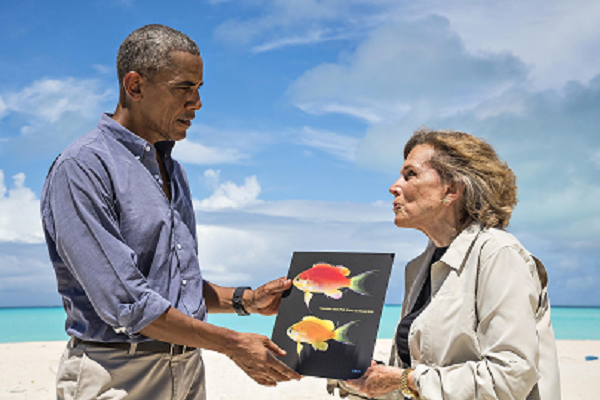- Researcher names new species of deep coral fish after the 44th President of the U.S.
- Scientists don’t know if the new species is threatened, but it is found in the Papahānaumokuākea Marine National Monument.
- Discovery hints at how many species still await names.
The eight year tenure of Barack Obama has come to a close, and as you reflect on his time in the White House you may think of his efforts to reduce carbon emissions, his commitment to healthcare reforms, or his nuclear agreement with Iran. But you may be missing one small part of his legacy – a 61.5 millimeter legacy, to be exact. A new species of fish, Tosanoides obama or colloquially, Obama’s fish, has been named for our former president to honor his dedication to marine conservation.
Dr. Richard Pyle, a scientist with the Bishop Museum of Honolulu, first observed the fish during a diving excursion at Kure Atoll off the coast of Hawaii. The discovery site is located within the Papahānaumokuākea Marine National Monument, a protected area expanded by Obama during his last days in office.
This monument is the largest fully-protected conservation area in the U.S., amounting to 1,508,870 square kilometers (582,578 square miles). It was first established as the Northwestern Hawaiian Islands Marine National Monument in 2006 under the Bush Administration. The park received its Hawaiian name the following year.

Tosanoides obama was discovered in a deep coral reef, also known as a mesophotic reef. These ecosystems are found 100 to 500 feet below the surface, and because they exist in such deep water, resient species must be able to survive with less sunlight. Globally, these ecosystems have been explored not only off the coast of Hawaii, but also in other tropical and subtropical areas such as the Mariana Islands and the Samoa Islands.
According to Pyle, these ecosystems are a new frontier for marine exploration. With advances in diving technology, we can now dive deeper than ever before.
On the day of the discovery, Pyle first mistook Obama’s fish for a common species, the fairy bass (Pseudanthias thompsoni).
“Except there was something on its dorsal fin. My first thought was that it was a parasite clinging to the dorsal fin,” Pyle said. “As I got a closer look, I saw that it wasn’t a parasite at all, but rather a bright red spot with a blue ring. That’s when I suddenly realized it was a fish I didn’t recognize.”

Described in the journal ZooKeys, Obama’s fish is only one of three in its genus and the only species endemic to the Papahānaumokuākea Marine National Monument. The two other species, Tosanoides filamentosus and Tosanoides flavofasciatus, are also found within the northwestern regions of the tropical and subtropical Pacific. Obama’s fish is distinguished by slightly different characteristics, such as life color, smaller body size, and unbranched pectoral fin rays.
Scientists have only sighted five individuals of Tosanoides obama to date, once by Pyle and again by Brain Greene, the director of the Association for Marine Exploration. Greene encountered Obama’s fish at Pearl and Hermes Atoll, also within Papahānaumokuākea.
Pyle concludes that the species is probably abundant in even deeper places which scientists are currently unable to dive. Because so little is known about Tosanoides obama’s life history, habitat, and distribution, conservationists are not yet able to say if the species is threatened, nor can they determine what its biggest threats might be.
The expansion of Papahānaumokuākea by Obama was a major victory for the protection of deep coral reefs.
“In particular these deep habitats are vulnerable to deep-sea fishing and coral collecting through trawls and dredging, which would be devastating to this species,” Pyle said. “The expanded protection keeps shipping traffic and other possible sources of pollution away from the main populations for this and other species”.
Within deep coral reefs lie boundless opportunities for the discovery of new and endemic species. But because these reefs are harder to access and more difficult for us to see, their conservation can be arguably more challenging than their shallow reef counterparts.
Unfortunately, even protected areas cannot be shielded from global stressors such as climate change and ocean acidification. The public can, however, recognize that marine ecosystems are incredibly resilient and protect them from the threats we can more readily control.
According to Pyle, the next step forward in marine conservation will be to create policies and international treaties to protect the high seas, those vast areas of the ocean that do not fall under the control of any single country. The high seas constitute 60 percent of our oceans and remain relatively unprotected.
As for Tosanoides obama, this species is quite literally one small fish in a greater ocean of biodiversity. In addition to its tribute to the 44th President of the United States, it symbolizes the wealth of unidentified species we have yet to discover and understand.
“Biodiversity is unambiguously the most valuable asset of planet Earth for the future of Humanity,” said Pyle. “It’s like a giant library of information refined over nearly four billion years of evolution…Currently we’re like kindergartners running through the biological equivalent of the Library of Congress. We are just barely beginning to understand the potential value of the information that surrounds us.”
Sources:
Deep Coral Reefs. (n.d.). National Oceanic and Atmospheric Administration. Retrieved February 21, 2017, from https://www.pifsc.noaa.gov/cred/deep_coral_reefs.php
Papahānaumokuākea Marine National Monument. (2017). National Oceanic and Atmospheric Administration. Retrieved February 21, 2017, from http://www.papahanaumokuakea.gov/new-about/
Pyle RL, Greene RD, Kosaki RK (2016) Tosanoides obama, a new basslet (Perciformes, Percoidei, Serranidae) from deep coral reefs in the Northwestern Hawaiian Islands. ZooKeys641: 165-181. https://doi.org/10.3897/zookeys.641.11500
NOTE: An earlier draft of this article was mistakenly published previously. It has been updated to the correct version.
